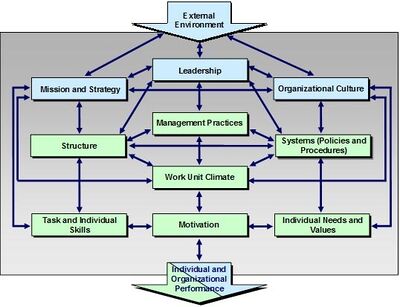Burke-Litwin Model of Organizational Performance and Change
Burke-Litwin is a system science model that describes the linkages among the key factors that affect performance, and determine how change occurs in an organization. Through the use of this model system, engineers obtain data on what organizational factors to change and why. Higher level factors (blue boxes) have greater weight in effecting organizational change; a change in any variable will ultimately affect every other variable. The Figure below, Burke-Litwin Model of Organizational Performance and Change, depicts the system science approach:
This Performance and Change Model, developed in 1992 by two organizational change consultants, W. Warmer Burke and George H. Litwin, is a tool used to understand an organization's component parts and how they relate to each other in a time of change. A common reason for a change initiative failing is all areas of the organization affected by the change are not accounted for. Therefore, using this model can reveal what areas of the business are affected and how they are interrelated. The model also demonstrates the hierarchy of factors within an organization and hence the flow of influence from one factor to the next. The model is an example of ‘open systems theory’, which suggests change comes from external influences. The authors describe the model as a mechanism that portrays “…the primary variables that need to be considered in any attempt to predict and explain the total behavior output of an organization, the most important interactions between these variables, and how they affect change”. There are four groups of elements within an organization; the external environment, transformational factors, transactional factors and performance. Each group then contains various elements of the organization. The diagram above demonstrates which elements belong in which group, how they interact with each other and the overall hierarchy of an organization.[1]
Burke-Litwin Model - The Three Levels of Change
This Burke-Litwin Model identifies three levels of changes in an organization which are derived by 12 factors or drivers of change.
- Transformational Change: Transformational factors are deeply embedded processes and characteristics of the organization. Any change that occurs to these factors will have substantial consequences to the rest of the organization. It is also true that any other change will require these factors’ input and hence the arrows go in both directions. Lasting change to any of these factors is likely to sweep change throughout the organization. These factors will be most strongly affected by the external environment and will also have the strongest influence on transactional factors.
- Transactional Change: Transactional factors refer to day-to-day operations within the organization. The authors argue these factors are strongly affected by management, rather than leadership. Change in these factors is only likely to lead to lasting change if, in turn, the transformational factors are also affected.
- Individual and Organizational Performance – This factor is the overall output of the organization. This can be represented in many different ways, commonly turnover, productivity, customer satisfaction etc.
The Burke-Litwin model - Drivers of ChangeCite error: Closing </ref> missing for <ref> tag
Advantages of Burke Litwin Model of Change.
- This is a comprehensive model covers all the important factors into account to explain why change is happening, what is driving change and helps in formulating change strategy.
- This model explains factors of change on the basis of cause and effect relationship which helps to have complete understanding about organizational change.
- This model explains the meaning and distinction between transformational and transactional level of change leadership in an organization.
Limitations and Disadvantages of Burke Litwin Model of Change
- The critics of this model are of the view that over simplification of different factors of change results into producing sub factors which actually makes it a more complex model.
- This model only focuses on what drives change and fail to explain how to implement change.
- It puts external environment factors on the top which drives change which is not always the case. There are internal factor as powerful factors which lead to organizational change.

